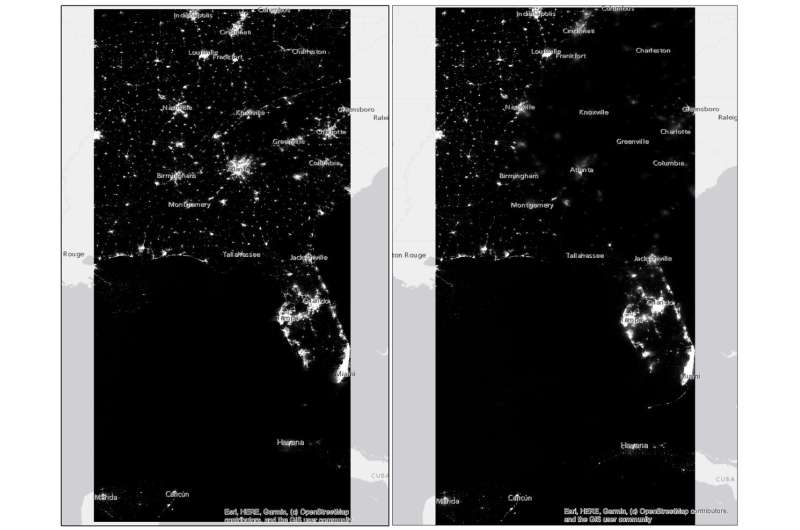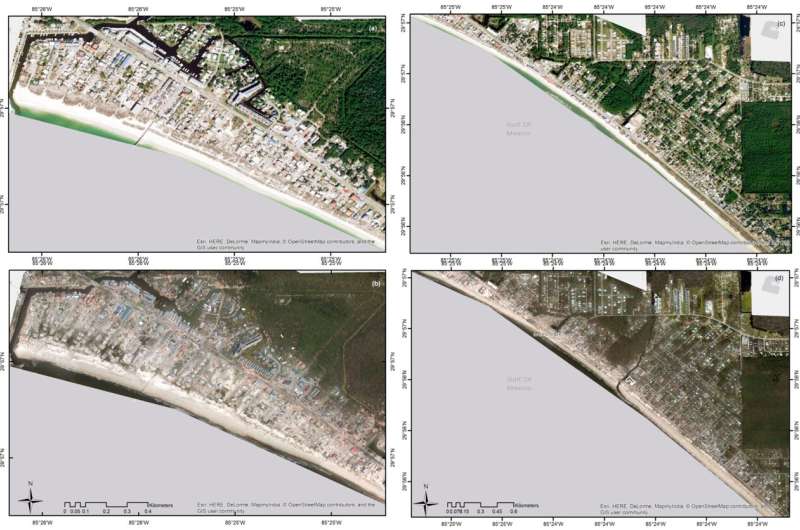This article has been reviewed according to Science X's editorial process and policies. Editors have highlighted the following attributes while ensuring the content's credibility:
fact-checked
trusted source
proofread
Nighttime light data shows inequities in restoring power after Hurricane Michael

Among the many devastating impacts in the aftermath of a hurricane are power outages, which can take days or even weeks to restore. Communities grappling with the loss of electricity may encounter obstacles in accessing vital services, including food, fuel and health care.
In 2018, Hurricane Michael, a Category 5 storm, wreaked havoc in Florida as it made landfall in the United States. It was the strongest recorded to hit the Florida Panhandle with winds of nearly 161 miles per hour and storm surge reaching heights between 9 and 14 feet. Mexico Beach, Panama City Beach and Cape San Blas experienced the highest level of devastation.
Several counties in the hardest hit areas reported that 100% of their customer accounts were out of electricity for several days. Eight of the 14 counties in the area are classified as rural and five of these counties have poverty rates above 20%. At the household level, loss of electric power can have ripple effects for families without a means to salvage and replace refrigerated items.
After a disaster, assessing damage quickly is crucial for initiating search and rescue and prioritizing the restoration of utilities. However, inconsistent public data on power outages and a lack of standardization hinder emergency response efforts. This is particularly challenging in diverse, disadvantaged or rural areas.
To unravel the complex effects of Hurricane Michael on the Florida Panhandle, researchers from Florida Atlantic University and collaborators combined remote sensing data, official outage records, and census information to provide an in-depth view of the initial damage, the restoration process, and its impact on vulnerable populations.
They examined the correlation between damage levels and power restoration rates by overlaying estimated percent recovery derived from NASA's Visible Infrared Imaging Radiometer Suite (VIIRS) Day/Night Band (DNB) (also known as nighttime lightdata) with a reclassification of NOAA's National Geodetic Survey Emergency Response Imagery. This imagery was categorized into various types of land damage, including debris, sand, water, trees, barren land, and roofs around Mexico Beach.
Results of the study, published in the journal Remote Sensing, reveal notable differences in power-restoration rates between urbanized and rural areas and between disadvantaged and more affluent communities. The findings indicate that block groups with higher proportions of minorities, multi-family housing units, rural locations, and households receiving public assistance experienced slower restoration of power compared to urban and more affluent neighborhoods.
Through hotspot analysis, significant variations in power-restoration rates were highlighted, with urban areas, particularly those surrounding Tallahassee, demonstrating notably higher rates compared to rural regions and areas heavily affected by structural damage, like Mexico Beach.

"Delayed recovery in key infrastructure, such as the power grid, will further devastate these communities. Operation of air conditioning units, food storage, entertainment, working, schooling and even drinking water for households with wells, all rely on electricity," said Diana Mitsova, Ph.D., senior author and chair and professor of the Department of Urban and Regional Planning within FAU's Charles E. Schmidt College of Science.
"Consequently, power loss and delayed restoration have a profound negative impact on households and families, ranging from health to economic productivity."
For the study, researchers used outage data averaged over a week from the Florida Public Service Commission and NASA's VIIRS DNB data. They also used spatial lag models to study how the speed of power restoration related to socioeconomic status. Researchers differentiated between urban and rural counties using a classification scheme from the U.S. Centers for Disease Control and Prevention and the National Center for Health Statistics.
Restoration rates and curves were developed for 14 counties to compare power-restoration patterns between these regions. They also aggregated electrical service loss and restoration rates at the block group level using data from the 2013–17 American Community Survey.
"Our findings further confirm that insufficient post-disaster recovery disproportionally affects households and families in disadvantaged neighborhoods and rural communities," said Mitsova. "These communities tend to be vulnerable to natural disasters and often suffer more severe damage compared to other areas."
In addition to underscoring the importance of revisiting building codes and fostering new mutual aid agreements between rural electrical cooperatives and larger entities within and outside Florida, findings from this study also highlight the need for more focused scholarship on disparate disaster impacts on smaller rural communities, coastal and agricultural ecosystems and policy solutions to address these disparities.
"Our study emphasizes the importance of integrating socioeconomic factors into disaster preparedness and recovery-planning efforts, stressing the need for targeted interventions to mitigate disparities in recovery times following natural disasters," said Mitsova. "Such initiatives and scholarship hold promise for addressing future challenges and enhancing the resilience of predominantly rural and underserved communities."
Study co-authors are Yanmei Li, Ph.D., an associate professor, FAU Department of Urban and Regional Planning; Ross Einsteder; Tiffany Roberts Briggs, Ph.D., chair and associate professor, Department of Geosciences, FAU Charles E. Schmidt College of Science; Alka Sapat, Ph.D., professor and director, School of Public Administration, FAU Dorothy F. Schmidt College of Arts and Letters; and Ann-Margaret Esnard, Ph.D., distinguished university professor of public management and policy, Georgia State University.
More information: Diana Mitsova et al, Using Nighttime Light Data to Explore the Extent of Power Outages in the Florida Panhandle after 2018 Hurricane Michael, Remote Sensing (2024). DOI: 10.3390/rs16142588
Provided by Florida Atlantic University



















